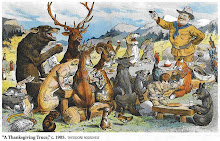What is the price of a polar bear?
Government wants to know impact of adding bears to list of at-risk species
By Max Paris CBC News
When a German hunting enthusiast flies from Berlin to Iqaluit to get a polar bear in the sights of his rifle, the price tag will cost him $15,000.A nature enthusiast who takes a trip from Seattle to Churchill, Man., for three days of tundra-buggy encounters will pay $5,200. Hunting expeditions, wildlife-watching tours — these are easy costs to calculate when gauging the price of polar bear.
But what are polar bears actually worth?
Canada is home to about 15,000 of the world's largest land carnivores. They roam around in Canada's collective backyard and in our imagination — but it's hard to put a price on their existence.
Environment Canada is going to try.Earlier this month, the federal government department awarded a contract to EcoRessources Consultants to determine the total economic value of the polar bear.The federal government wants to understand the impact of adding these majestic creatures to the list of wildlife species at risk.Essentially, they are trying to figure out what it will cost if they protect polar bears."We're trying to put that value on what it means to the economy and what it means just to have a polar bear around," explains Mary Taylor, Director of Environment Canada's conservation service.
So, what's a polar bear worth now? What will it be worth if you can't hunt it anymore?Paul Irngaut knows the answer to both of those questions."For us Inuit, the polar bear is invaluable — economically and socially," asserts the wildlife officer for Nunavut Tunngavik, Inc. (the territory's land claims manager).End the polar bear hunt, and Irngaut predicts nuisance bears, an exploding population and the loss of much-needed jobs.Irngaut believes there is something much bigger than just the protection of the polar bear behind this study."Why are they putting a value on polar bears? Is it because of climate change? If that's the case then say it. And take steps to deal with the climate change issue," he says.In the meantime, Irngaut just hopes the Inuit will be consulted in this study.
EcoRessources must finish its report by the beginning of February 2011. Afterwards, Environment Minister will, eventually, make a determination about whether or not to add the polar bear to the species at risk list.
But what are polar bears actually worth?
Canada is home to about 15,000 of the world's largest land carnivores. They roam around in Canada's collective backyard and in our imagination — but it's hard to put a price on their existence.
Environment Canada is going to try.Earlier this month, the federal government department awarded a contract to EcoRessources Consultants to determine the total economic value of the polar bear.The federal government wants to understand the impact of adding these majestic creatures to the list of wildlife species at risk.Essentially, they are trying to figure out what it will cost if they protect polar bears."We're trying to put that value on what it means to the economy and what it means just to have a polar bear around," explains Mary Taylor, Director of Environment Canada's conservation service.
Wildlife value rarely gauged
These types of assessments are difficult, but not uncommon. There is a whole cohort of economists who specialize in them. What they try to do is quantify elements of the environment that have always just been taken for granted.For example: An undisturbed tundra habitat or a river with protected marine wildlife. The goal is to assign a value to undeveloped ecosystems in order to compare their worth to potential industrial development, such as a mine or a fishery. It may sound naive and idealistic, but according to Vic Adamowicz, it is absolutely necessary."If we don't try to do these kinds of assessments, then often these species have implicitly a zero value placed on them," argues Adamowicz, a professor at the University of Alberta's Department of Rural Economy.So, what's a polar bear worth now? What will it be worth if you can't hunt it anymore?Paul Irngaut knows the answer to both of those questions."For us Inuit, the polar bear is invaluable — economically and socially," asserts the wildlife officer for Nunavut Tunngavik, Inc. (the territory's land claims manager).End the polar bear hunt, and Irngaut predicts nuisance bears, an exploding population and the loss of much-needed jobs.Irngaut believes there is something much bigger than just the protection of the polar bear behind this study."Why are they putting a value on polar bears? Is it because of climate change? If that's the case then say it. And take steps to deal with the climate change issue," he says.In the meantime, Irngaut just hopes the Inuit will be consulted in this study.
EcoRessources must finish its report by the beginning of February 2011. Afterwards, Environment Minister will, eventually, make a determination about whether or not to add the polar bear to the species at risk list.










No comments:
Post a Comment